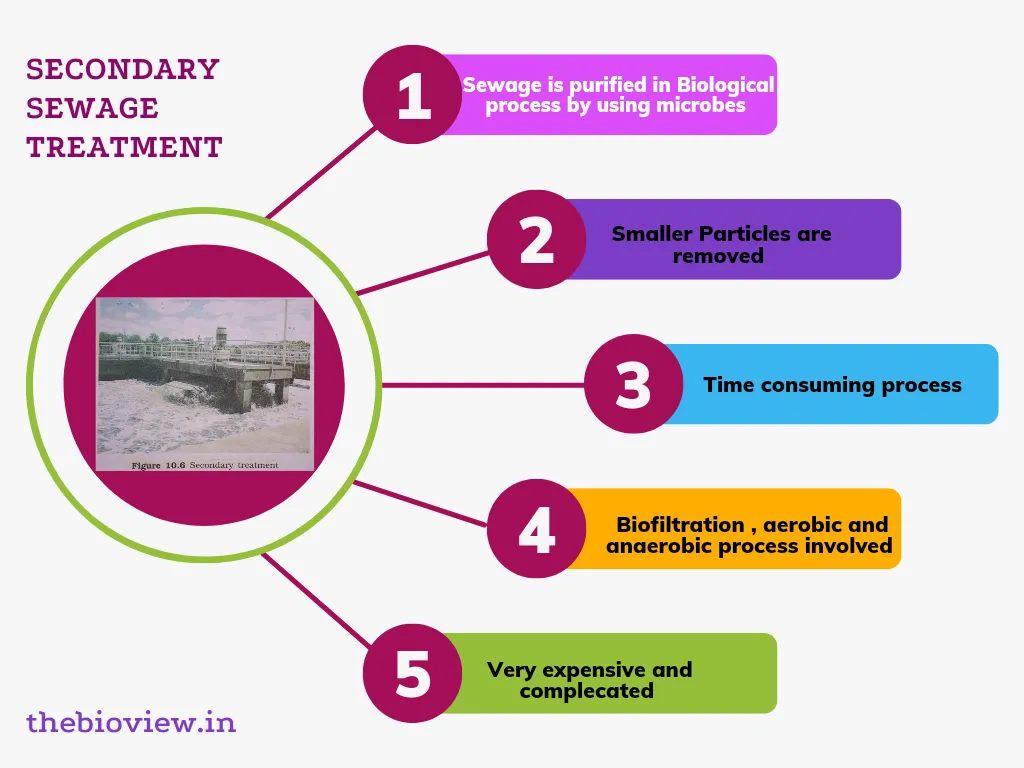The key difference between primary and secondary sewage treatment is that primary treatment is based on sedimentation and filtration method whereas secondary treatment is done by biological processe with help of microorganisms.
What is Sewage ?
Sewage is the waste water coming from domestic households and industries. It is also called municipal waste. Composition of sewage include human excreta, organic and inorganic waste, pathogenic microbes. Sewage is treated in Sewage Treatment Plants (STPs) before disposal.
Difference Between Primary and Secondary Sewage Treatment
| Primary Sewage Treatment | Secondary Sewage Treatment |
| Sewage is removed by sedimentation and Filtration process. | Sewage is purified in Biological process by using microorganisms. |
| Large and solid particles are removed from waste water by this process. | Small and organic particles treated in this method. |
| It is a mechanical process. | It’s a biological, aerobic and aerobic process. |
| Less time constraints. | Time consuming. |
| Inexpensive and less complecated. | Expensive and complecated. |
Primary Sewage Treatment
Primary sewage treatment basically involves physical removal of particles (that might be large and small) from the sewage through filtration and sedimentation. These are removed by following processes –
- Initially floating debris is removed by sequential filtration
- Then the grit (solid and small pebbles) are removed by sedimentation.
- All solids that settle from the primary sludge and supernatant forms the effluent.
- The effluent from the primary settling tank is taken for secondary treatment.
Secondary or Biological Sewage Treatment
Secondary treatment is also called Biological Sewage treatment. steps of this process –
- The primary effluent is passed into large aeration tanks where it is constantly agitated mechanically and air is pumped into it.
- This allows vigorous vigorous growth of useful microbes into Flocs (masses of bacteria associated with fungal filaments to from a mess like structure).
- while growth, this organisms consumes the major part of the organic matter in the effluent. This process significantly reduces the BOD (Biochemical Oxygen Demand) of the effluent.
- The sewage water is treated till the BOD is reduced.
- After that the effluent is then passed into a settling tank where the bacterial flocs are allowed to sediment. This sediment is called activated sludge.
- A small part of activated sludge is pumped back into aeration tank to serve as innoculum.
- The remaining major part of the sludge is is pumped into large tanks called Anaerobic Sludge Digesters. Here other kinds of bacteria, which grow anaerobically, digest the bacteria and fungi in the sludge.
- During this digestion bacteria produce a mixture of gases such as methane, hydrogen sulphide and carbon dioxide. These gases form Biogas and can be used as source of energy as it is inflammable.
- The effluent from the secondary treatment plant is generally released into natural water bodies linke river and streams.

Importance of Secondary Treatment
Microbes play a major role in treating millions of gallons of waste water everyday across the world. This methodology has been practiced for more than a century now, in almost all parts of the world. Till date, no man made technology has been able to rival the microbial treatment of sewage or second sewage treatment.
